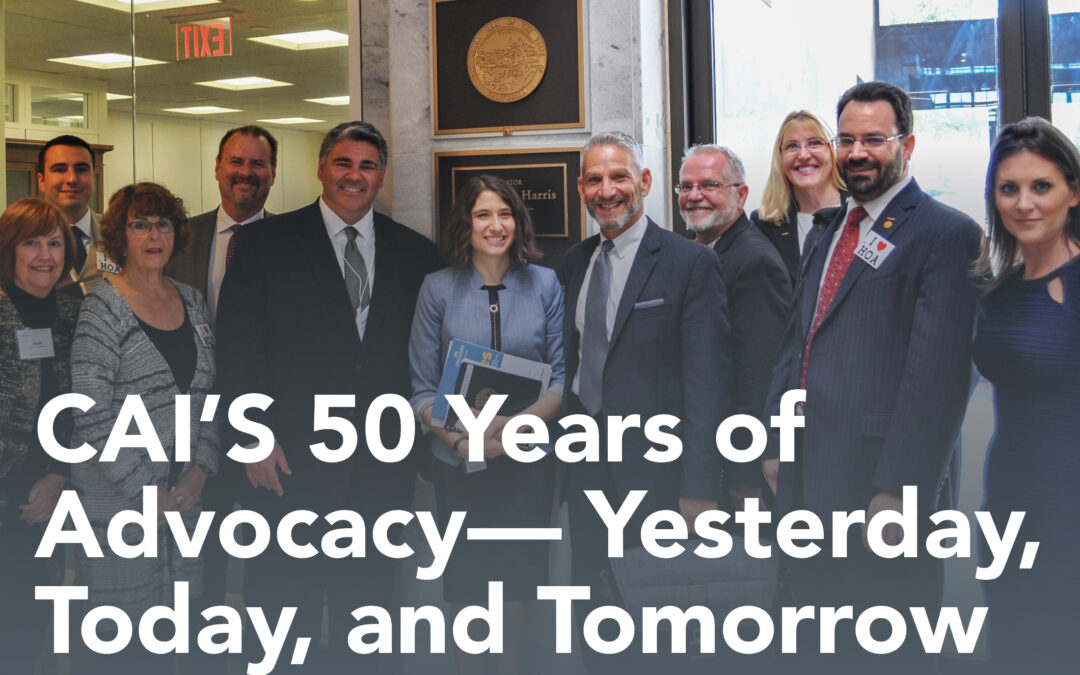Advocacy and government affairs have been a core function of CAI from the start. Fifty years ago, the U.S. Department of Housing and Urban Development, along with other stakeholders and CAI’s founders, recognized the uniqueness and potential of the community association housing model.
The legal framework for condominiums, housing cooperatives, and homeowners associations are found in state statutes. According to Creating Community Association Law: True Tales from Early Pioneers, the first condominium act was enacted in 1958 in Puerto Rico. The Federal Housing Administration (FHA) translated the act and introduced its model, Horizontal Property Act. By 1967, every state adopted a version of the FHA model act.
The Uniform Law Commission, a nonpartisan, nonprofit organization providing clarity and stability to critical areas of state law released the Uniform Condominium Act in 1977—just four years after CAI was founded. The Uniform Law Commission’s Joint Editorial Board included CAI representation on the drafting board for many years. CAI members who volunteered their time to represent CAI interests included attorneys William Breetz (Connecticut), Robert Diamond, a fellow in CAI’s College of Community Association Lawyers (Virginia), James Jones (Virginia), Benny Kass (Washington, D.C.), Carl Lisman (Vermont), David Ramsey, CCAL fellow (New Jersey), and Bill Thomas (Washington, D.C.) Alabama, Arizona, Kentucky, Louisiana, Maine, Minnesota, Missouri, Nebraska, New Mexico, Pennsylvania, Rhode Island, Texas, Virginia, and West Virginia adopted the Uniform Condominium Act.
Following the growth of planned communities and homeowners associations, the Uniform Law Commission drafted the Uniform Common Interest Ownership Act (UCIOA) in 1982. UCIOA is intended to be the singular law addressing condominiums, homeowners associations, and planned communities. UCIOA was updated in 1994, 2008, and 2021. Alaska, Colorado, Connecticut, Delaware, Minnesota, Nevada, Vermont, Washington, and West Virginia have adopted a version of UCIOA.
CAI’s first legislative action committee was established in California and approved by the CAI Board of Trustees in 1986. The Florida Legislative Alliance was approved shortly thereafter. By 1996, at least half of the states formed state LACs to advocate for community associations. Today, 36 states have LACs with more than 600 members serving on these committees. CAI hires lobbyists in 25 states, the District of Columbia, and on the federal level to advocate for CAI members. CAI tracks legislation in all 50 states and on the federal level, following approximately 2,000 bills each year.
To assist LACs, we create public policies that articulate our position on issues of importance to the community association housing model. The first set of policies were approved by the CAI Board of Trustees in 1983. Today, there are policies on 47 topics including collection of assessments, electric vehicle charging stations, reserve studies and funding, alternative dispute resolution, fair housing, board member training, manager licensing, insurance, political signs, risk management, government regulation of community associations, and building inspections. For a full list, visit www.caionline.org/publicpolicies
CAI’s emphasis and effectiveness in advocating for CAI members have grown tremendously. Together, advocates, legislative action committee members, lobbyists, and staff lead and influence legislation for the good of the common interest housing model that makes community associations preferred places to call home.
We’ve accomplished a lot in 50 years and have thousands of volunteers to thank for our success today. I hope you join us in our advocacy adventure in the future.




It’s great knowing this history. Thanks Dawn and team.
What an amazing group. I am considering serving. I was very inspired while listening to the group at the National Conference.